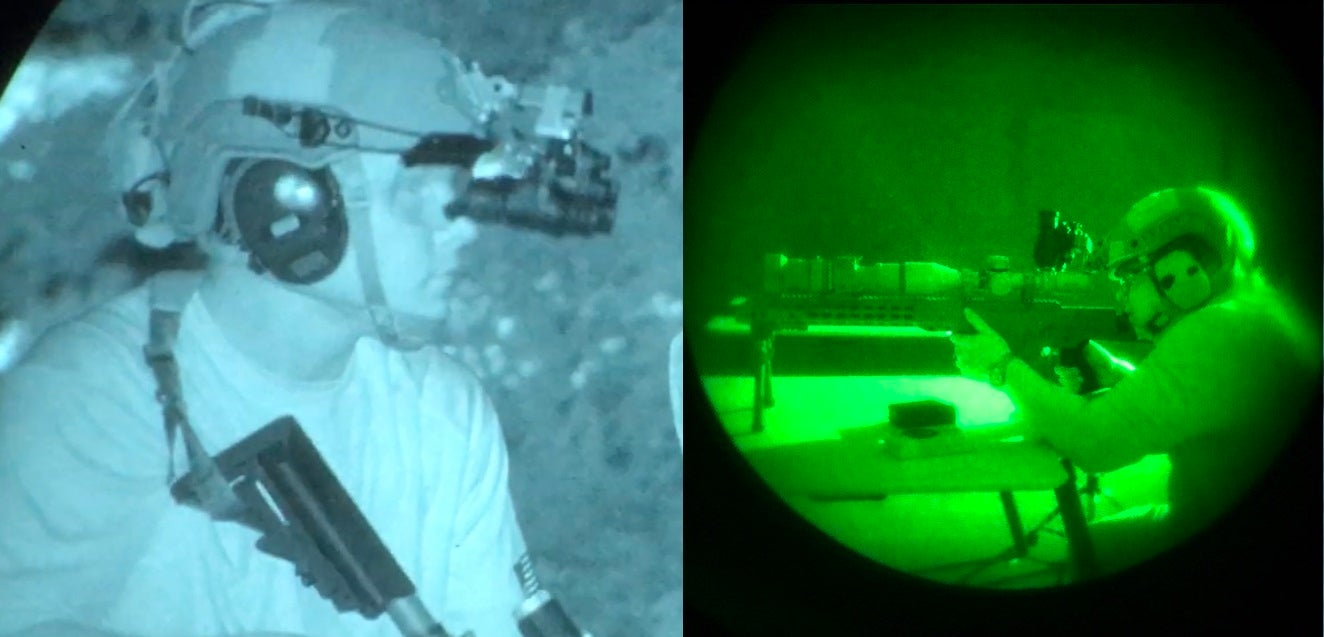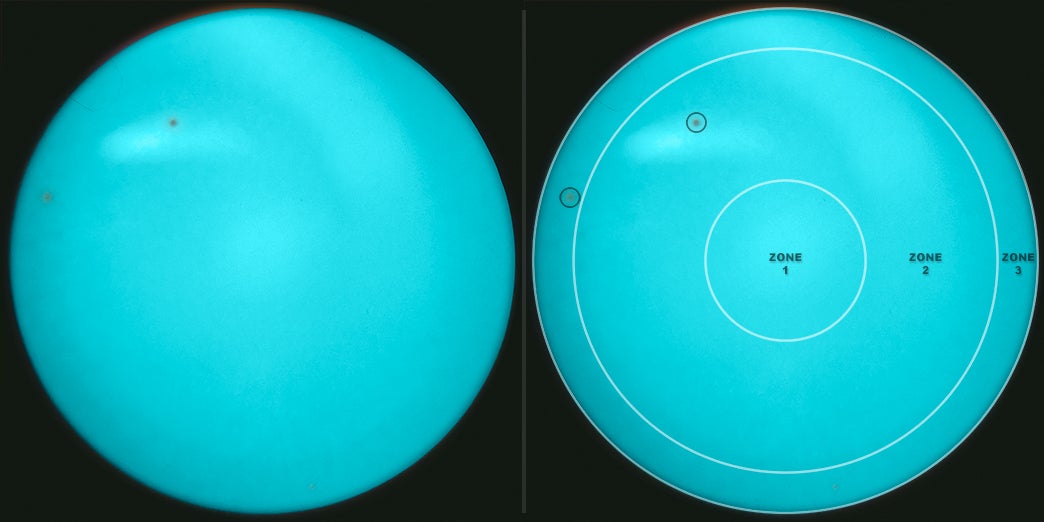Travis Olander 03.07.23
We’ve covered the most popular types of night vision devices. While thermal scopes, IR illuminators, and digital NVGs have their merits, many hunters and tactical collectors still prefer good ol’ phosphor image intensifiers: military night vision that call up names and acronyms like L3Harris, PVS-14, BNVD 1431 MKII, and plenty of other acronyms. Many of those acronyms determine the performance of a night vision monocular or pair of goggles. Regardless of the type or maker, all green and white phosphor-powered NVGs are produced, recorded, and sold based on a set of important specifications. Let’s go over those important night vision specs, cover what matters and why, and recommend the minimum specs for any tube or goggles to ensure you get best low-light bang for these pricey bucks.
Night Vision – White Phosphor vs. Green Phosphor Tubes

Before buying a night vision monocular or goggle, you’ll need to decide whether you want a green phosphor or white phosphor tube. The “image tube,” as referenced on so many product pages, is the device inside the NVG that amplifies light. It contains a photocathode and microchannel plate. White phosphor tubes (pictured above, left) provide a noticeable improvement in image clarity, contrast, and eye fatigue compared to green tubes (above, right), but they’re much more expensive. So, if a budget matters more than everything else, stick with a green tube.
Night Vision – Autogating vs. Auto and Manual Gain
These buzzwords – autogated, manual gain, auto tube, and the like – describe the functionality of a tube’s brightness. While autogating and gain work together, they are fundamentally different features. Autogating protects the image intensifier tube from being damaged by bright lights. With autogating functionality, the tube will restrict how many photons make it through the photocathode and microchannel plate. This helps ensure the device doesn’t get burned out if there’s too much ambient light. Gain refers to a tube’s ability to adjust the brightness for the user’s eyes. Auto gain tubes automatically adjust brightness. This is sometimes called “ABC,” or Auto Brightness Control. Manual gain tubes don’t have ABC. They require the user to turn a knob or dial to control the brightness of the image.
Night Vision – “Gen 3” vs. Other Generations
Most night vision devices available today are Generation 3. That just means, at the time of this publication, they’re the latest and greatest. Gen 3 tubes and NVGs have the best resolution, brightest images, best low-light performance, and importantly, the most life expectancy. A Gen 3 image intensifier can last well over 10,000 hours of use. Gen 2 tubes last about 5,000 hours. Gen 1 tubes last around 1,500 hours.
Night Vision – Specifications 101
Now you know what all that jargon means when you look up different monoculars and goggles, but diving deeper, you’ll see certain specs listed on night vision product pages. The most common being “FOM,” or “Figure of Merit.” There are acronyms aplenty, too: EBI, SNR, PC, LP/MM. Let’s break it all down.
Resolution / “Res” (LP/MM) – Resolution, or “res,” describes the image clarity a night vision tube can provide. LP/MM is the technical term. It means “line pairs per millimeter.” Think of LP/MM as the night vision equivalent to pixel count on a TV or monitor. The more lines per millimeter, the smaller each line is. A tube with more, smaller lines is like a screen with more, smaller pixels per inch. The more, the better: the resulting image is higher definition. You’ll always see resolution listed as a range, like “64 – 72,” or “72 – 81.” New, Gen 3 tubes have 64 LP/MM as a minimum standard for mil-spec units. Any tube with 72 LP/MM or better is considered top-tier.
Signal to Noise Ratio (SNR) – Think of SNR as those little black and white dots that come through a spotty cable TV connection. The less static, the clearer the picture. Night vision SNR is no different: a tube with a higher SNR ratio will have a clearer picture with less static. A lower SNR value will have more static. The minimum value you should aim for is 25:1. A “good” tube is typically 30:1 while top-tier tubes provide an SNR of 33:1 or higher. Sometimes, the SNR of a device will only list the first number which is the signal value. So, “SNR 30” would be the same as “SNR 30:1.”
FOM (Figure of Merit) – FOM, or “Figure of Merit,” is the single most common spec you’ll see listed for any night vision device. The FOM is a simple calculation: it takes the resolution (LP/MM) number and multiplies it by the SNR ratio. So, a tube with an SNR of 30 and a resolution of 64 would yield a FOM of 1,920. That number – 1,920 – is the figure you should aim for if you want a high-quality Gen 3 tube. A “budget” tube will have a FOM range of 1,400 to 1,800.
It’s important to remember that because FOM is a multiplication of two different specs, two tubes with the same FOM could perform differently to the naked eye. A tube with a lower resolution (say, 58), but a higher SNR (33) could also have a FOM of about 1,920. That’s why it’s important to see if an advertised night vision device lists its resolution range. Most manufacturers will. If you take the resolution range and divide the advertised FOM by the minimum and maximum values of that resolution, you can estimate the tube’s SNR to get a better idea of its real performance.
To keep things simple, if you want a high-end Gen 3 NVG, look for a minimum FOM rating of 2,400 (or 2,376, to be precise). At this Figure of Merit, you’re likely to get a tube with a resolution of 72, and a minimum SNR of 33. Be prepared to drop some serious cash for any NVG with a FOM value of 2,000+.
Gain (Lumens) – We covered auto and manual gain, but the absolute value of a night vision’s possible light amplification is what gain really is. It determines a tube’s capability in low-light conditions. Gain is determined by dividing the light input by the corresponding light output. Like other specs, gain is measured numerically. Most mil-spec Gen 3 sport a Gain value of at least 40,000. A “good” to high-grade tube provides 60,000 to 70,000. It’s easy to assume that, fundamentally, gain is the most important spec of a night vision device – it is, after all, literally defining and measuring an NVG’s intended purpose.
More gain doesn’t necessarily mean better performance because the light output amplifies everything being inputted, noise also gets amplified. In short, the higher the gain, the grainier and less crisp the image. Even “mediocre” gain values provide incredible light amplification – especially for Gen 3 devices. That’s why SNR and Resolution – again, represented by FOM – is what really matters most.
Equivalent Background Illumination (EBI) – When a night vision device is turned on, the tube produces a minimal amount of ambient light. This is true even if there are zero photons being picked up by the image intensifier. This ambient light output is called background illumination, or EBI. The lower the tube’s EBI value, the better. That’s because in extremely low-light conditions, any objects or scenes that match or fall below the amount of ambient light produced by the tube itself cannot be seen. EBI values are measured by single digits. A high-end unit will afford an EBI value below 1.0. A “good” unit will fall below 2.0. The mil-spec maximum EBI value is 2.5.
Halo – Halo measures the amount of bloom produced by sources of light. The higher the halo value, the greater the bloom. If you’re into photography, you’ll recognize this as the Bokeh effect produced by out-of-focus light sources. Halo is typically measured at values usually between 0.5 and 1. Halo can have a pretty big negative impact on overall night vision performance and clarity, especially in urban environments. In fact, it’s one value this writer personally prefers to keep low over most others including overall FOM.
A tube with a halo value of 0.6 might appear to have half the amount of bloom from a single light source, if compared to another, similarly-spec’d tube with a halo value of 0.8. That’s a 50% increase in bloom for a 25% increase in actual halo value. A good tube should have a halo value of about 0.7. A high-end tube will have a value closer to 0.5.
Spots – Last, but not least, is the thing that will piss off any neurotic NVG user: tube spots. Spots are small black marks present in the outputted image. Think of spots like dead pixels on your smartphone screen or TV.

In practice, spots are usually not something to worry too much about. Tubes’ spots are categorized by zones within the image: Zone 1 is the center 25% of the image. Zone 2 measures the middle 50%, and zone 3 measures the outer 25%. In the above example (a white phosphor PVS-14), we can see two spots in zones 2 and 3. Spots can develop during the tubes’ manufacturing process. Crafting image intensifiers is simply a challenging process and many new, Gen 3 tubes will have a small spot, or two.
Spots can also form over time from bright lights, even with autogating. Red dots from optics and bright lamps – even, in rare cases, viewing a full moon – can damage the tube and leave a spot. Now you’re learned up on night vision, and you can start shopping around for a good optic, monocular, or set of goggles. Check out the latest night vision stuff we saw at SHOT Show 2023, like Holosun’s new night vision optic.
